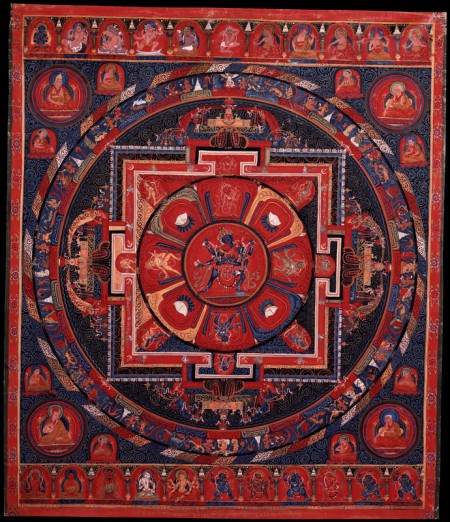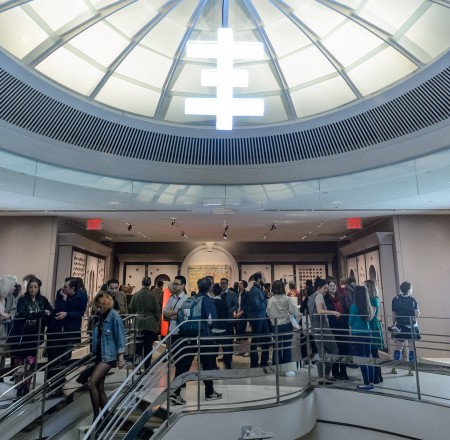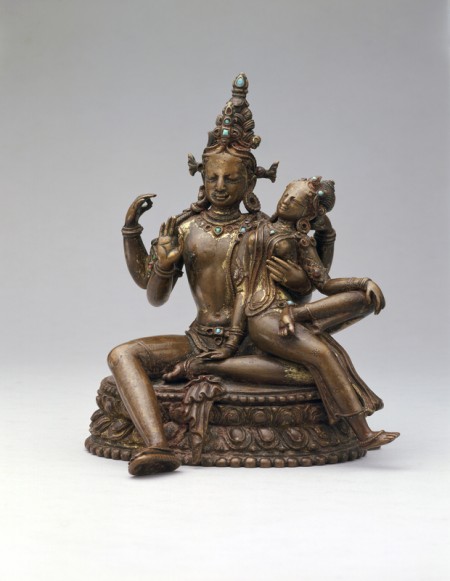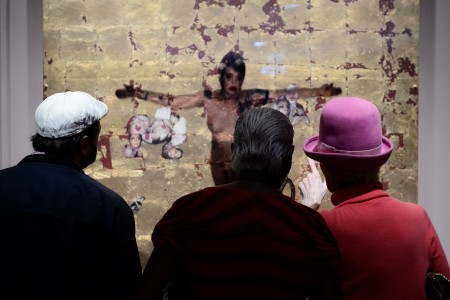
Genesis Breyer P-Orridge: Try to Altar Everything, the latest exhibition at the Rubin Museum of Art, challenges visitors to consider the ways that meaning and identity are constructed in everyday life and across cultures. To that end, the artist employs a variety of techniques and terminology that may be unfamiliar to those who are new to Breyer P-Orridge’s work.
The terms below are used throughout the exhibition and represent some of the central themes of Genesis Breyer P-Orridge’s artistic practice:
Mandala

Mandala, Sanskrit for “circle,” is a complex symbol in Asian religions. In Tantric Buddhism it represents the palace of a deity. Practitioners visualize the deity dwelling at the core of the mandala as well as that deity’s attendants and the palatial gardens that surround them. In tantric meditation, practitioners identify with the central deity as a means of cultivating enlightenment, the goal of their religious practice. The mandala is a locus of divine power that is believed to bless and protect devotees.
Psychic Cross

Genesis Breyer P-Orridge created the psychic cross as the visual emblem of the network she cofounded called Thee Temple ov Psychick Youth (TOPY) and h/er music group Psychic TV. Breyer P-Orridge designed the cross with specific proportions, with the ratio of the shorter bar to the longer bars as two to three because twenty-three is a key number in TOPY thought. The psychic cross relates broadly to the Latin cross and more closely to the three-barred Orthodox or Byzantine cross. It appears throughout Breyer P-Orridge’s work.
Shiva-Parvati/Ardhanarishvara

Shiva is one of the major deities in the Hindu pantheon and forms a divine couple with the goddess Parvati. Shiva takes many forms, both benevolent and wrathful, and is often worshipped in the phallic form of a lingam. Some of the most common attributes of Shiva are that he has a third eye, holds a trident, and wears a tiger skin. Sometimes Shiva and Parvati are joined as a half-male, half-female figure called Ardhanarishvara. Breyer P-Orridge adopted this as a Pandrogeny ideal.
Thee Temple ov Psychick Youth

Thee Temple ov Psychick Youth (TOPY) was a forum co-founded in 1981 by Genesis Breyer P-Orridge as an outgrowth of h/er work in the music group Psychic TV. TOPY was concerned with occultism within contemporary culture. Its primary goal was the self-directed expansion of consciousness among its members, including through the process of creating sigils. Breyer P-Orridge stated that the core of TOPY’s practice was discipline, helping members focus on and actualize their desired lives. Psychic TV was the public face of TOPY during its eleven active years.
Take a tour to understand these concepts and read part one of the lexicon guide to learn more about the exhibition, Genesis Breyer P-Orridge: Try to Altar Everything.

